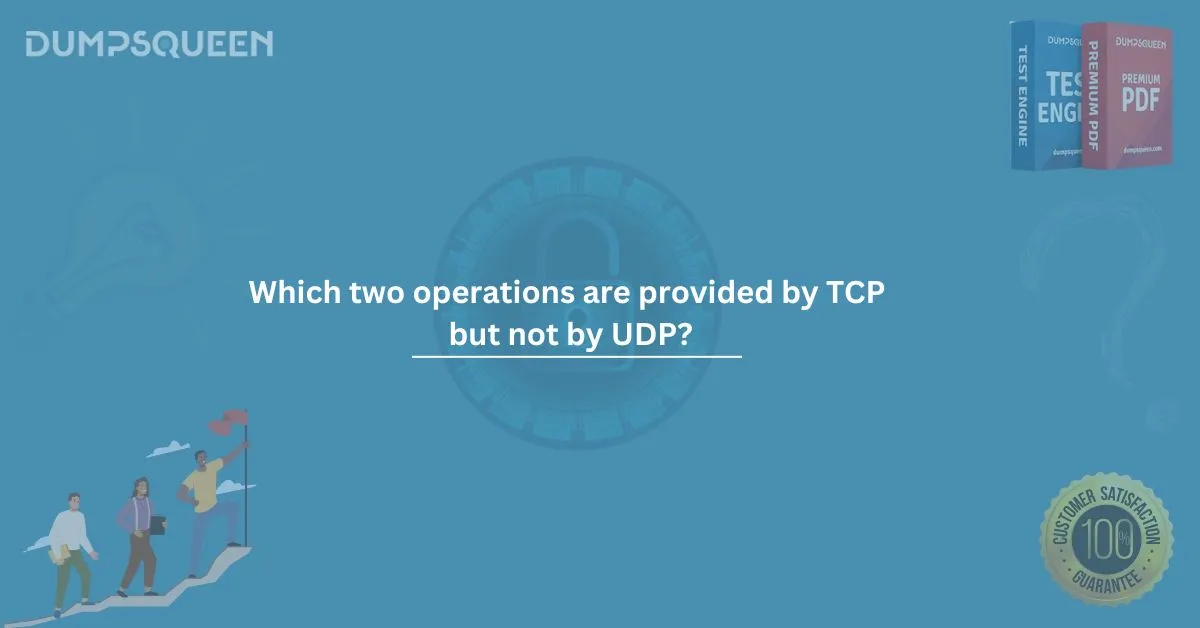When diving into the fundamentals of networking protocols, it's essential to understand the differences between Transmission Control Protocol (TCP) and User Datagram Protocol (UDP). Both of these protocols are crucial in data transmission, but they operate in fundamentally different ways. In this post, we will discuss the two operations that TCP provides but UDP does not.
Introduction to TCP and UDP
TCP and UDP are both transport layer protocols, but they serve distinct purposes within the OSI (Open Systems Interconnection) model. Understanding the features of each can help you decide when to use one over the other, especially in critical networking applications.
- TCP (Transmission Control Protocol) is a connection-oriented protocol. It ensures reliable data transfer through mechanisms like error checking, flow control, and congestion control. These features make TCP suitable for applications where data integrity and reliability are critical, such as file transfers, web browsing, and email.
- UDP (User Datagram Protocol), on the other hand, is a connectionless protocol. It offers no guarantees for delivery, ordering, or error correction. As a result, UDP is typically used for applications that require speed and can tolerate some level of data loss, such as live video streaming, VoIP, and online gaming.
Operations Provided by TCP But Not by UDP
The two key operations that TCP offers, but UDP lacks, are Connection Establishment and Reliable Data Transfer. Let’s examine these two operations in detail.
Connection Establishment
One of the most fundamental operations that TCP provides is the three-way handshake, which is used to establish a connection between the sender and receiver before data transfer begins. This process ensures that both parties are ready for communication and helps prevent data loss.
- TCP Three-Way Handshake:
- SYN: The client sends a synchronization (SYN) packet to the server, requesting a connection.
- SYN-ACK: The server responds with a synchronization-acknowledgment (SYN-ACK) packet, confirming the connection request.
- ACK: Finally, the client acknowledges the server’s response, and the connection is established.
This handshake ensures that the connection is properly initialized before any data is transmitted. It also allows both parties to negotiate certain parameters, such as maximum segment size (MSS) and the initial sequence number.
In contrast, UDP does not require a connection establishment phase. It simply sends data packets to the destination without ensuring that the receiver is ready or that the data is successfully received.
Reliable Data Transfer
TCP provides reliable data transfer through mechanisms like error detection, acknowledgments, sequence numbers, and retransmission of lost packets. These features ensure that data is delivered accurately and in the correct order. If a packet is lost during transmission, TCP automatically resends it.
Key features involved in reliable data transfer:
- Error Detection: Every packet in a TCP connection contains a checksum that helps detect errors. If a corrupted packet is received, TCP requests a retransmission.
- Sequence Numbers: TCP assigns sequence numbers to data packets to ensure they are reassembled in the correct order at the receiving end.
- Acknowledgments (ACKs): The receiver sends an acknowledgment back to the sender, confirming that the data was received successfully.
- Retransmission: If a packet is lost or corrupted, TCP will automatically retransmit it to ensure reliable delivery.
On the other hand, UDP does not provide reliable data transfer. It does not guarantee the order in which packets are received, nor does it have a mechanism for retransmitting lost packets. If a packet is lost, there is no built-in recovery system in UDP. This makes UDP more suitable for applications where real-time delivery is more critical than reliability.
Why These Differences Matter
These two operations — connection establishment and reliable data transfer — are essential for applications that need guaranteed delivery of data in the correct order, such as:
- File Transfers (e.g., FTP)
- Web Browsing (e.g., HTTP)
- Email Communication (e.g., SMTP)
In contrast, for applications like video conferencing or online gaming, where speed is critical and some data loss is acceptable, UDP is preferred.
Conclusion
In summary, TCP offers connection establishment and reliable data transfer, while UDP is faster and lighter but lacks these features. When deciding which protocol to use, it’s important to consider the application’s requirements. If your application demands accuracy and data integrity, TCP is the better choice. However, for applications that prioritize speed and can tolerate occasional data loss, UDP is ideal.
By understanding these fundamental differences, network professionals can make informed decisions about which protocol best suits their needs.
Sample Questions & Answers
Q1: Which of the following operations is provided by TCP but not UDP?
a) Connection Establishment
b) Error Checking
c) Data Flow Control
d) Connectionless Transmission
Answer: a) Connection Establishment
Explanation: TCP requires a connection establishment phase (the three-way handshake), while UDP does not.
Q2: How does TCP ensure reliable data transfer?
a) By using sequence numbers and retransmitting lost packets
b) By sending packets without checksums
c) By using time stamps for each packet
d) By not acknowledging received packets
Answer: a) By using sequence numbers and retransmitting lost packets
Explanation: TCP ensures reliable delivery through mechanisms like sequence numbers, acknowledgments, and retransmissions.
Q3: Why might an application choose UDP over TCP?
a) The application requires guaranteed delivery and data integrity
b) The application needs fast, low-latency transmission
c) The application requires connection establishment
d) The application requires error-free data transmission
Answer: b) The application needs fast, low-latency transmission
Explanation: UDP is ideal for real-time applications where speed is more important than reliability.



